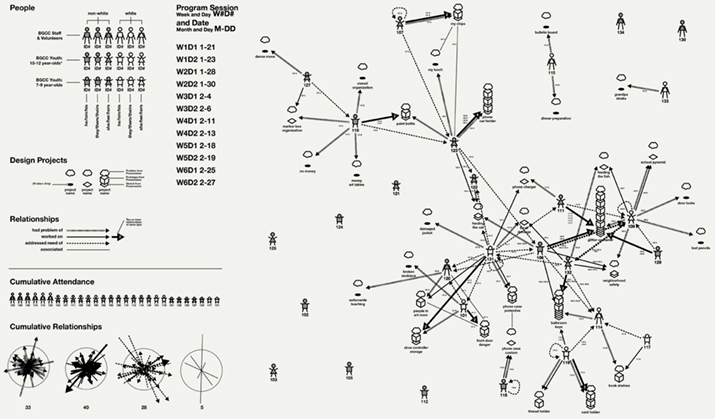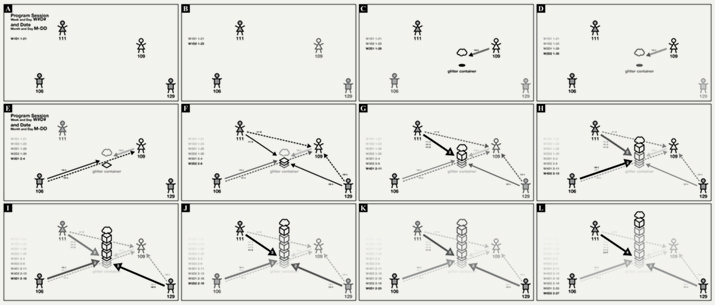Making for One Another: Design-based Making and Positive Youth Development
William A. Nickley 1,*, Sébastien Proulx 2, Elizabeth B.-N. Sanders 1, Lauren McInroy 3, and Susan Melsop 1
1 Department of Design, The Ohio State University, Columbus, Ohio, United States
2 Département de Design, École de Technologie Supérieure, Université du Québec, Montréal, Canada
3 College of Social Work, The Ohio State University, Columbus, Ohio, United States
This study explores integrating design-based making within Positive Youth Development (PYD) frameworks to expand design’s role beyond established educational contexts. While PYD programs have traditionally utilized arts- and sciences-based making, this research introduces design-based making as an approach that aligns with core PYD goals of fostering competence, confidence, connection, character, caring, and contribution (6Cs). The research details a six-week pilot program, Improve Our Club!, where 26 youths engaged in design-based making activities such as problem identification, sketching, and prototyping. Thematic analysis of youth design artifacts and presentations reveals that design-based making promotes expressions of the 6Cs and fosters self-efficacies connected to the activity of design. Using a novel network emergence mapping technique, the study illustrates how design-based making facilitated an emergent network of contributions among participants. Findings highlight how design-based making afforded youth opportunities to express contribution, providing evidence that the current 6Cs model does not account for the nature of design-based making, which essentially differs from arts-based and science-based making. This research shows how integrating design practices into youth development programs expands the relevancy of design as it fosters personal growth and social engagement and empowers youth to actively shape their own worlds beyond traditional educational contexts.
Keywords – Design-based Making, Positive Youth Development, Self-efficacy, Design-based Learning, Youth-led Design, Design-based Learning.
Relevance to Design Practice – This research highlights how design-based making can be integrated into youth development programs to support personal growth and social engagement. By leveraging design practices, this study positions design as a tool to examine and foster connection across a network of individuals and afford youth an avenue to contribute to the design of their world, expanding design’s role beyond established educational contexts.
Citation: Nickley, W. A., Proulx, S., Sanders, E. B.-N., McInroy, L., & Melsop, S. (2025). Making for one another: Design-based making and positive youth development. International Journal of Design, 19(1), 21-44. https://doi.org/10.57698/v19i1.02
Received November 21, 2023; Accepted February 3, 2025; Published April 30, 2025.
Copyright: © 2025 Nickley, Proulx, Sanders, McInroy, & Melsop. Copyright for this article is retained by the authors, with first publication rights granted to the International Journal of Design. All journal content is open-accessed and allowed to be shared and adapted in accordance with the Creative Commons Attribution 4.0 International (CC BY 4.0) License.
*Corresponding Author: nickley.3@osu.edu
William Nickley is an assistant professor of Design at The Ohio State University whose practice merges industrial design expertise with social-impact initiatives. Building on eight years of industry experience in consultancy, in-house, and nonprofit leadership roles, he employs design-based making (DBM) and person-centered design (PCD) frameworks for guiding inclusive, justice-oriented creative processes. As a member of the Ohio State DESIS Lab, Nickley engages in co-design with LGBTQIA+ youth to develop culturally competent healthcare practices while also exploring youth-focused DBM in out-of-school contexts. His work integrates Positive Youth Development principles to foster youth self-efficacies and catalyze community-driven action. Nickley is a co-founding board member of Local Tech Heroes.
Sébastien Proulx is an associate professor in the Department of Design at the École de Technologie Supérieure de Montréal (University of Québec). From 2017 to 2025, he served as an associate professor of Design at The Ohio State University. Dr. Proulx holds a PhD in Design and a Master of Applied Science in Design and Complexity from the University of Montreal. Additionally, he completed a postdoctoral fellowship in public health at the University of Montreal’s Public Health Research Center (IRSPUM). His research and teaching activities explore social design practices and the role of design in improving public services.
Elizabeth B.-N. Sanders pioneered many of the methods being used today to drive and inspire design from a human-centered perspective. Liz has practiced co-designing across all the design disciplines. She is now in the process of bringing co-design practices to disciplines beyond design in order to address the challenges we face for the future. In practice, Liz leads MakeTools, where she explores new spaces in emerging design landscapes. She is also a faculty member in the Department of Design at The Ohio State University. Liz has a Ph.D. in Experimental and Quantitative Psychology and a B.A. in both Psychology and Anthropology. She is co-author of the book, “Convivial Toolbox: Generative Research for the Front End of Design” (BIS, 2012).
Lauren McInroy is an associate professor in the College of Social Work at The Ohio State University. Her multi-disciplinary research has two primary aims: (1) using internet-enabled information and communication technologies (ICTs) to foster improved outcomes and increase well-being for lesbian, gay, bisexual, transgender, queer, and other sexual and/or gender minority (LGBTQ+) adolescents and emerging adults; as well as (2) enhancing the successful application of ICTs in social work research, education, and practice.
Susan Melsop is an associate professor in the Department of Design at The Ohio State University. Her body of research integrates placed-based design-build pedagogy with eco-social justice issues. She is Co-Director of the Design for Social Innovation & Sustainability (DESIS) Lab and recently served as a Faculty Fellow for Arts & Design Engagement at OSU. Her recent work, Design Matters in Brazil, addresses human rights issues through design-build activities with the PopRua as community partners. Her post-graduate studies in East Asian philosophies and Buddhism inform her approaches to engaged scholarship, contemplative pedagogy, and collaborative creative place-making.
Introduction
Design scholars acknowledge the value of collaboration between design and related disciplines that pursue shared social goals. This includes exploring practice frameworks that offer opportunities for integrating the goods of design (Guersenzvaig, 2021; Proulx, 2019). Design’s contributions to frameworks for developing youth—or fostering young people’s growth to become responsible, engaged members of society—have been characterized primarily by design’s role as a learning aid. This is epitomized in educational frameworks integrating design, referred to as Design-based Learning (DBL) (The Center for Building Educations, n.d.), exemplified in public K-12 education (Davis et al., 1997; Lee & Breitenberg, 2010; Nhem, 2015), arts education (Davis, 1998), engineering and STEM education (Crismond & Adams, 2012; Gómez et al., 2011), middle school science education (Doppelt et al., 2008), professional entrepreneurship training (Bacigalupo et al., 2016) and technical university education (Wijnen et al., 2000). However, design has more to offer youth than enhancing their formal learning.
In their examination of design-oriented after-school programs, Vlahos (2022) highlights an emerging awareness of design’s potential to “affect issues within and around social and economic justice, community functionality, equity, diversity and inclusion, and the effective bolstering of social mobility” (2), within youth programs, calling for further investigation into not only educational outcomes but also other empowering effects of youth programs employing design. In other words, there is a need to investigate design’s contribution to youth development beyond learning. To address this need, our paper surfaces the well-established paradigm of Positive Youth Development (PYD), a developmental process and an approach to youth programming focused on fostering personal development (Lerner et al., 2015), which characterizes avenues for fostering youth growth beyond learning as expressions of the 6Cs: competence, confidence, connection, character, caring, and contribution (Lerner, Lerner, et al., 2005).
PYD has a history of relying on making as a program delivery strategy; programs commonly rely on either arts-based or sciences-based making (not to be confused with STEM making, later discussed) to engage with and develop youth (Bevan et al., 2017). However, programs employing such types of making essentially differ from how a program would be structured using a design-based making logic. Given that, as once suggested by Cross (1982), the cultures of design, the arts, and the sciences have different ways of knowing, from which we derive our definitions of design-based, arts-based, and sciences-based making, we explore and discuss how PYD programs leveraging design-based making would (1) support PYD outcomes linked with the 6Cs, and (2) do so in different ways than a program structured around arts-based or sciences-based making. In order to answer these questions, this research explores the pragmatic and epistemic contributions of design-based making for PYD through a close examination of a pilot PYD program employing design-based making. We argue that design might invest in PYD as a new practice area, expanding the social relevancy of design’s praxis. In so doing, this research contributes to an ongoing conversation about how the field of design, as it expands, transforms, and adapts, might express its value and invest in new territories and cross-disciplinary opportunities (Muratovski, 2015).
Background
The research was carried out through experiences with a group of youth engaged in a six-week out-of-school PYD program named Improve Our Club! (Local Tech Heroes, 2019), with a core structure and specific activities revolving around design-based making. Youth modes of engagement in activities and program outcomes illuminate how design-based making augments PYD program delivery options and the scope of developmental objectives it may serve.
Positive Youth Development
PYD is a developmental process, an approach to youth programming that seeks to foster youths’ positive maturation into productive and engaged members of society (Lerner et al., 2015). Conceptually, PYD is an interdisciplinary area of practice and research (Benson et al., 2006) that bridges domains including Education, Social Work, and Developmental Science. The theoretical base and origins of PYD lie in the developmental, psychological, and cognitive sciences (Lerner, Lerner, et al., 2005), and integrate models from public health, epidemiology, social work, sociology, and psychopathology (Catalano et al., 2002). A PYD approach to youth programming is asset-based, i.e., it recognizes, utilizes, and enhances young people’s strengths, resources, and capacities and promotes positive outcomes for young people (Anyon & Jenson, 2014; Interagency Working Group on Youth Programs [IWGYP], 2020; Lerner, 2005). PYD programming, commonly structured as out-of-school programs, can be characterized as situated—it aims to engage youth within their communities, schools, organizations, peer groups, and families (IWGYP, 2020). Examining PYD program goals and approaches—specifically making—reveals an avenue for design’s contribution to PYD.
PYD Goals
PYD is valued for supporting a range of positive outcomes commonly framed in PYD practice using the 6Cs model (Table 1), an expanded version of the well-established 5Cs model (Lerner, Almerigi, et al., 2005; Lerner, Lerner, et al., 2005; Lerner et al., 2015; King et al., 2005), a framework for structuring PYD programs and measuring their outcomes (Deutsch et al., 2017).
Table 1. The 6Cs of positive youth development.

Fostering the 6Cs in youth is a goal for PYD programs, as well as the mechanism through which PYD contributes to society by fostering the potential of young individuals, nurturing them to become active and responsible contributors to the well-being of society as a whole. PYD programs aim to set conditions for youth to express the 6Cs (Lerner, Lerner, et al., 2005); youth expressions of the 6Cs during a PYD program indicate its success.
Self-efficacy
Of the various developmental targets of the 6Cs of PYD, self-efficacy—within the 6Cs as confidence—has a theoretical foundation from which we derive indicators of the potential for a PYD program to foster youth development. Self-efficacy can be defined as one’s beliefs or expectancies in their capabilities or in using their abilities to accomplish a goal. In other words, a youth who believes they can accomplish whatever they set their mind to has high self-efficacy. Stemming from Albert Bandura’s (1977) seminal work on self-efficacy theory and its incorporation into Bandura’s (1986) Social Cognitive Theory, self-efficacy is a well-established and relevant conceptual construct in the fields of education (Usher & Pajares, 2008) and particularly social, emotional learning (Collaborative for Academic, Social, and Emotional Learning, 2019), social work (Maddux et al., 2011), youth development (Tsang et al., 2012) and PYD programming (Lerner, Lerner, et al., 2005; Tsang et al., 2012).
Two areas of self-efficacy theory were relevant to the present study as lenses through which data could be viewed: archetypal self-efficacy experiences and particularized self-efficacy across five domains. Archetypal experiences are strategies to foster self-efficacy in individuals linked to several basic strategies and include four types of experiences (Maddux & Kleiman, 2016), shown in Table 2. Interventions meant to increase self-efficacy should provide people with a sense of efficacy for solving problems themselves (Maddux & Kleiman, 2016) and might strategically employ any number of archetypal experiences. Youth engagement in archetypal experiences during PYD program activities indicates opportunities to foster their self-efficacy.
Table 2. Archetypal experiences known to foster self-efficacy.

Self-efficacy can be measured in general or as particularized about specific criterial tasks in specific domains or situations (Bandura, 1997; 2006; Pajares, 1996). We selected five particularized measures of self-efficacy that were relevant to the present study and would be used in our outside-in analysis for their apparent relevance to design activities our study would employ. These include creative self-efficacy (Beghetto, 2006; Tierney & Farmer, 2002), communication self-efficacy (Gaffney, 2011), emotional self-efficacy (Kirk et al., 2008), technology self-efficacy (Shank & Cotten, 2014), and self-efficacy related to social justice via the Social Justice Scale (Torres-Harding et al., 2012).
Notably, this study does not use a particularized measure of design self-efficacy. Although Chien et al. (2022) claim to have measured but not yet validated industrial design self-efficacy along four key factors—problem solving, information collection, model prototyping, and project realization—and there has been work toward establishing an engineering design self-efficacy (Carberry et al., 2010; Major et al., 2020), a particularized measure of design self-efficacy—one that relies on a set of criterial tasks that uniquely define designing—has not been established. There are, however, strong indications linking designing and general self-efficacy in recent literature (Dow et al., 2010; Jobst et al., 2012; Ohly et al., 2017; Rao et al., 2020; Voigt et al., 2019; Vongkulluksn et al., 2021), as well as indications linking designing and creative self-efficacy (Jobst et al., 2012; Rao et al., 2020), despite inconsistent identification, application, and/or interpretation of self-efficacy concepts across these studies. For example, Dow and colleagues (2010) link parallel prototyping and iteration found in designing performed by novice graphic designers to increased ad design self-efficacy. However, the study did not employ standard procedures outlined by Bandura (1997, 2006) and Pajares (1996) to establish a particularized self-efficacy measure with validity and reliability. Though examining self-efficacy, the present study surfaces another dimension of youth development beyond learning, to which design may contribute.
“Making” in PYD and Design
As a developmentally appropriate practice, a PYD program must adjust its content, delivery, goals, and expectations to accommodate all youth’s needs and social and cultural contexts (Meschke et al., 2012), e.g., teaching 21st-century skills. To do this, PYD programs employ various strategies, including camp, wilderness, sports, arts, music, school, and mentoring programs (Waid & Uhrich, 2020), as well as STEM programs (Bevan et al., 2017). These established strategies employ making—or using knowledge, creativity, and skills to build and create things. However, not all making is the same.
Relevant to our conception of design-based making is Dilnot’s (1982) distinction between the socially significant activity of design—or designing—and the separate result of a design effort (e.g., a prototype, object, solution). Designing employs making, but of a different nature than making found in current PYD programs. We understand design-based making as a nonlinear process through which designers discover, define, develop, and deliver while upholding the design principles of centering on people, communicating, collaborating, and iterating (Design Council, 2019).
Design literature also provides a clue as to how design-based making differs from arts-based or STEM-based making, i.e., sciences-based making; we look to Cross (1982) for a convenient conceptualization of the differences between the cultures of design, the arts, and the sciences. By leveraging Cross’s (1982) cultures alongside additional models of design (Design Council, 2019) and art-making (Mace & Ward, 2002; Walker, 2004), we distinguish three types of making (Nickley, 2020) in Table 3.
Table 3. Comparison of types of making.

Although PYD programs use making to promote expression of the 6Cs, making is currently limited to arts-based and STEM-based making. In arts-based PYD programs, youth create visual, musical, or performing art, typically in an out-of-school setting (Ersing, 2009), wherein youth can be said to explore their emotions (Ersing, 2009; Waid & Uhrich, 2020) and practice self-expression. Making related to STEM activities has been defined as “the use of technological resources to build something of interest” (Chu et al., 2015, p. 3). An example of STEM-based making would be “designing and sewing a purse using conductive thread and Lilypad mini-processors, a task that can involve wiring, circuitry, and coding” (Bevan et al., 2017, p. 2), seemingly related to design but not articulated as such. Although implicitly related to the activity of design, making has also been shown to increase students’ self-efficacy by fostering the idea that they are makers—people who address problems by seeking do-it-yourself solutions—thus giving them a maker mindset (Chu et al., 2015). By centering design-based making within a PYD program, the present study aims to characterize any novel benefit of the activity of design; in other words, we aim to reveal, within the context of a PYD program, the extent to which doing design is beneficial to youth doing it.
Methodology
We first developed a PYD program mobilizing design-based making, then adopted an exploratory mixed-methods approach to investigate (1) how youth engage in design-based making with respect to problem identification, sketching, and prototyping (Table 3), and (2) how youth engage in PYD program goals, i.e., expressed 6Cs and particularized self-efficacies, to better understand (3) how design-based making accomplishes PYD program goals. We conducted a multi-week PYD program, gathering complex data in situ without interrupting program activities. We initially performed a thematic analysis of what youth made and how they described their design-based making during program activities. As it became apparent that youths’ engagement over time with (1) and (2) could nuance (3), we devised an experimental network emergence analysis to better understand the role of artifacts and presentations in forming links between youth over time. Our analyses highlight ways in which the activity of design enhances PYD program delivery in accomplishing established PYD program goals, thus demonstrating design’s potential to foster youth development beyond learning.
Sample and Data Collection
A PYD program called Improve Our Club! was developed in coordination with a local organization, the South Side Boys & Girls Clubs of Central Ohio (BGCCO) location—or the South Side Club. The South Side Club provides a range of PYD programs for the youth it serves in the Reeb-Hosack neighborhood, south of downtown Columbus, Ohio, one of the most underserved land tracts in the county, state, and nation (Nickley, 2020, pp. 47-51). Over six weeks in early 2020, the program engaged 26 youth in two age groups (7-9 year olds, 10-12 year olds) alongside six program staff and volunteers (a visual overview of participants is presented in Figure 11).
Through their design-based making during program activities, youth created design artifacts in the form of sketches and prototypes, which they shared with other program participants in presentations video-recorded by their peers or program volunteers using iPads. Photos of design artifacts and video-recorded presentations comprise the core dataset, complemented by daily attendance records and program documents.
Procedure
For an hour, twice weekly for six weeks, youth completed program activities linked with design phases and design-based making activities as outlined in Table 4.
Table 4. Improve Our Club! Program schedule and integration of design-based making.

In weeks 1-2, youth were challenged to discover a problem in their lives and then define and share it with their peers through a video-recorded problem presentation. In weeks 3-6, youth viewed one another’s problem presentations, and then selected someone else’s problem on which to focus their efforts to develop and deliver a solution in the form of sketch presentations and prototype presentations. Youth projects developed organically and asynchronously, often spanning multiple weeks. Local Tech Heroes (2020) provides additional programmatic details, including session plans and handouts online.
Analysis Approach
Our approach was informed by thematic analysis (Braun & Clarke, 2006; Fereday & Muir-Cochrane, 2006) and grounded theory (Corbin & Strauss, 2014; Saldaña, 2015). Specific sense-making steps were inspired by Lin’s (2019) application of thematic analysis to artifacts, as well as qualitative observations, inductive coding, thematic analysis, and Social Network Analysis used in several DTRS11 studies (Christensen et al., 2017).
To investigate (1) how youth engaged in design-based making, an inside-out analysis made use of an inductive coding approach centering youths’ program deliverables (Nickley, 2020, pp. 78-81, 238-262). To investigate (2) how youth engaged in PYD program goals, a subsequent outside-in analysis leveraged a deductive coding approach; we derived codes from the 6Cs of PYD, five particularized self-efficacies, and four archetypal experiences, as well as youth’s design-based making during specific design phases (Nickley, 2020, pp. 81, 82, 238-262). To explore (3) how youth design-based making promoted engagement in PYD program goals, we examined overlaps between our inside-out and outside-in approaches (Nickley, 2020, pp. 82, 260-264). Finally, we developed an experimental analysis we call network emergence mapping (Nickley, 2020, pp. 82-85, 262), inspired by an existing visualization method—a network sociogram, which stems from Social Network Analysis (SNA)—for viewing relationships within coded data and viewing emergent phenomena from a network-level perspective, a useful suggestion from a previous DTRS11 study (Bedford et al., 2017). Our analysis differs notably from SNA for its inclusion of the element of time. Our network emergence mapping allowed further investigation into connections between our inside-out and outside-in analyses and a deeper understanding of the nature of youth engagement in design-based making and PYD program goals as an emergent network of people and design projects. Additional details on the analysis are included in Appendix A.
Findings
This section integrates study results and relevant discussion for PYD practitioners and designers who would extend their praxis to include youth. We first highlight patterns within the data corpus linking youths’ design-based making to their expressions of the 6Cs of PYD and particularized self-efficacies through archetypal experiences. Then, we provide an overview of themes emerging from our analysis to accompany a presentation of individual youth projects and a macro-level view of youth making.
The data corpus includes videos (n = 78) from 22 youths totaling 65 minutes and 8 seconds, averaging 50.1 seconds each, from a Youth Design Making Videos dataset, which emerged as the focal point of our analysis. Videos from this dataset comprise three types of youth design presentations: problem (n = 33), sketch (n = 25), and prototype presentations (n = 20), wherein youth showed and described their design-based making. These presentations were transcribed into 396 speaker turns with 7,012 coded references from 60 inductive and deductive codes. Coding—through prolonged engagement with the data and extensive memoing—was performed and documented collaboratively by three researchers. 29 people with 801 coded references and 33 design projects with 492 coded references were included. Additionally, 121 photographs of youth-created artifacts were included, attributed to 13 youths, and linked with design presentations.
Overlap Between Youth Design Presentations and PYD Goals
We first present three figures highlighting the extent to which youth, while presenting their design-based making, expressed the 6Cs of PYD (Figure 1), had an archetypal experience (Figure 2), and exhibited particularized self-efficacies (Figure 3). While not a comprehensive analysis on their own, these figures provide a numeric overview and sense of correlation between youths’ collective design-based making and PYD program goals, providing context for their further characterization (i.e., transcribed presentation selections and photographs) in the subsequent thematic analysis results. Figures 1, 2, and 3 also give a sense of a progression of correlation between design-based making, from problem to sketch and prototype presentations, and PYD program goals.

Figure 1. Youth Design Presentations vs. 6Cs of PYD: Numeric values represent the total number of youth presentations wherein a speaker turn was coded for one of the 6Cs of PYD. Bar colors correspond to Presentation Type; a higher number indicates a stronger link between a program activity and the expression of one of the 6Cs.
Figure 1 shows that while presenting their work, youth presentations mostly expressed connection (48) and contribution (37), with fewer expressing confidence (5), competence (6), character (2), and caring (9). This trend suggests that design-based making, which prioritizes solving problems for others, as shown in Table 3, naturally highlights external, community-oriented skills within the 6Cs of PYD. Compared to sketch and prototype presentations, the higher relative expression of caring (5) and lower relative expression of contribution (7) in problem presentations hints that different phases of the design process support different PYD goals by affording expressions of different 6Cs.

Figure 2. Youth Design Presentations vs. Archetypal Experiences: Numeric values represent the total number of youth presentations wherein a speaker turn was coded for an archetypal experience. Bar colors correspond to Presentation Type; a higher number indicates a stronger link between program activity and archetypal experience.
Figure 2 shows a strong link between imagined and performance experience archetypes and all three types of presentation, suggesting design-based making offers opportunities for youth to build their self-efficacy primarily as they imagine and share their work. Compared to sketch and prototype presentations, there were relatively fewer imagined experiences in problem presentations, reinforcing the previously mentioned idea that different phases of the design process support different PYD goals, in this case, by affording different types of experiences known to foster self-efficacy. Figure 2 suggests that verbal persuasion (9) and vicarious (0) experiences were not strong avenues to foster youth self-efficacy during presentations. However, this may be indicative of a limitation of our study design, which did not capture youth interactions outside of presentations; we suspect these archetypal experiences may indeed happen elsewhere during a design-infused PYD program as students discuss their ideas with peers and see one another prototype and present work.

Figure 3. Youth Design Presentations vs. Particularized Self-efficacies: Numeric values represent the total number of youth presentations in which speaker turns were coded for a particularized self-efficacy. Bar colors correspond to Presentation Type; a higher number indicates a stronger link between a program activity and the expression of a particularized self-efficacy.
In sketch and prototype presentations, there is a pattern of exhibiting communication, creativity, and technology self-efficacy compared to other particularized self-efficacies (Figure 3). The high number of presentations (19) coded for communication suggests a link between presenting a problem and exhibiting communication capacity. Instances of presentations exhibiting emotional & empathy self-efficacies seem to decrease as a design project progresses from problem presentation (12) to sketch presentation (9) and then to prototype presentation (4). Presentations exhibiting technology self-efficacy trend upward as a design project progresses from problem presentation (7) to sketch presentation (14) and then to prototype presentation (16). The highest number of presentations exhibiting emotional & empathy self-efficacies were during problem presentations (12).
Thematic Overview
Emerging from our analysis were two primary themes organized into seven sub-themes (Table 5), which represent the most salient connections found within the data between program activities, design-based making, and expressions of the 6Cs of PYD and youth self-efficacy.
Table 5. Primary themes and sub-themes.

Primary Theme 1: A Design Journey is Personal
Our first theme—A design journey is personal—provides an intimate look into Improve Our Club! by presenting findings centering on four youth experiences connected with individual youth, P132. We highlight P132’s journey here because of the ways in which she exemplified the youth experience in the program; like many youths, P132 missed several program sessions, but she still participated in each type of design-based making activity, which allowed us to see a cross-section of their experiences and outcomes of Improve Our Club! Findings highlighted data excerpts from P132 and others in her network, offering evidence for how program participants expressed the 6Cs of PYD and encountered opportunities to foster their self-efficacy through their design-based making.
Sub-theme 1A: My problem—Youth Naturally Connect to Their Worlds
At the intersection of design-based making and the 6Cs goal of connection are youth problem presentations (Figure 1); program participants would ultimately discover and define 33 problems, forming the foundation of 33 design projects. Exemplified in Table 6 is the personal way in which participants engaged in their first design-based task, which suggests how the discover and define phases of design-based making promote the PYD 6Cs goal of connection.
Table 6. Problem presentation excerpts from participant #132 and for projects in her network.
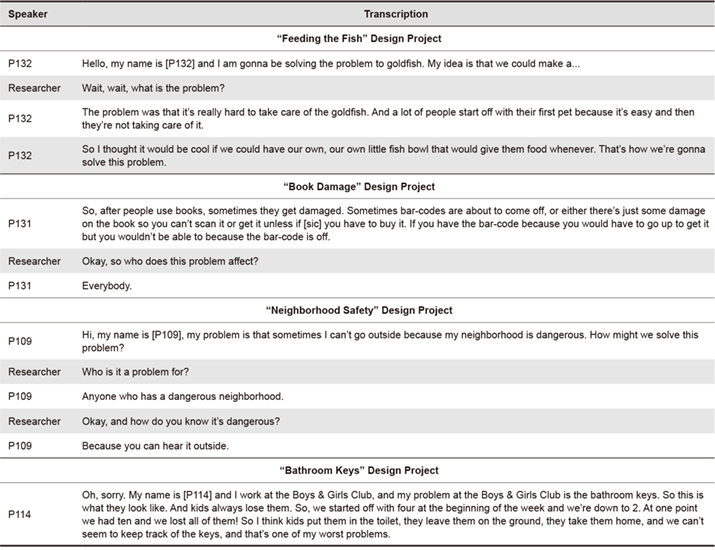
Youth chose to describe problems from their own lived experiences; at the individual level, problem presentations were “my problem.” P132, P131, and P109 shared issues from their homes, schools, or neighborhoods. Others, including P114 (a BGCCO staff member), presented problems related to the South Side Club. Personal connections anchored in the problem-based foundations of design projects set the stage for later expressions of contribution.
Sub-theme 1B: Our Problem—Connection to Contribution through Design-based Making
Expressions of the 6Cs goal of connection in problem presentations led to subsequent expressions of connection and contribution. During weeks 3 through 5 of Improve Our Club!, youth watched others’ problem presentations and then chose a problem to address through design-based making. Subsequent design sketches and prototype presentations showcased expressions of connection as youth imagined others’ experiences, then contributed as youth designed solutions. Program participants presented a total of 25 sketches and 20 prototypes, collectively developing solutions for 20 of the 33 problems discovered and defined. We highlight one of P132’s solutions to P109’s neighborhood safety problem (Figure 4, Table 7).
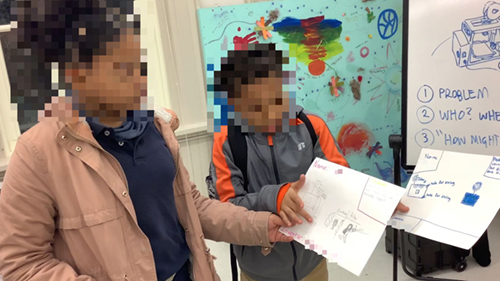
Figure 4. P132 and P106 share their ideas to solve P109’s neighborhood safety problem.
Table 7. P132 and P106 present their ideas for neighborhood safety to solve P109’s problem.
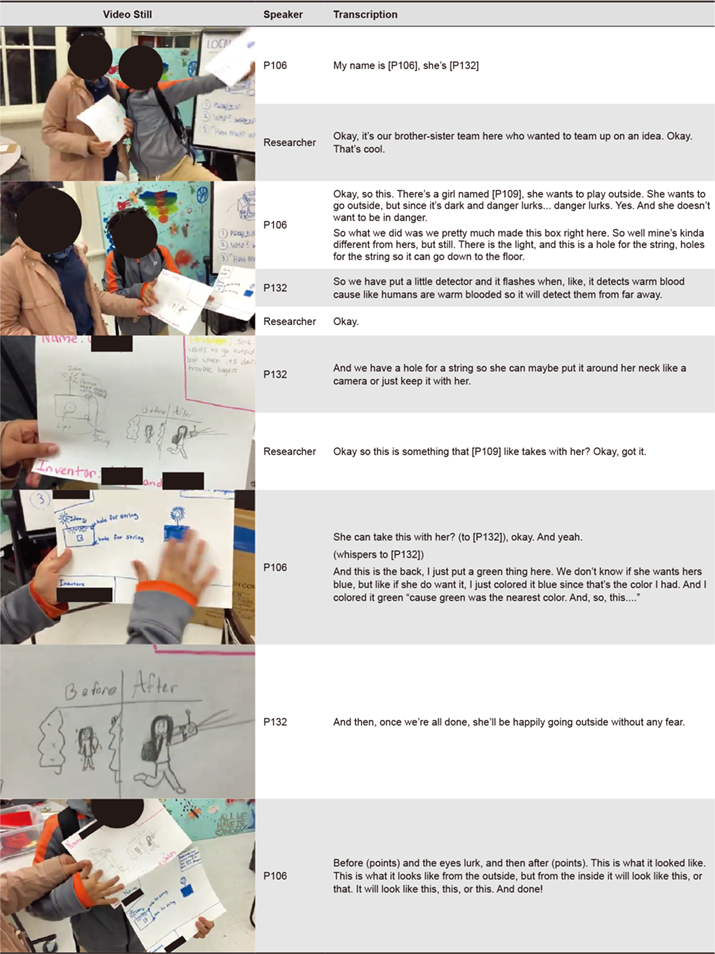
P132 and P106 formed a team to address P109’s problem. Their presentation (Figure 4, Table 7) focused on the physical appearance and features of a device they thought P109 could wear to detect danger in the dark.
A portion of participant P132’s sketch (Figure 5) exemplified something observed in several youths’ work at this stage: empathy and care for others, and a transition from “my problem” to “our problem.” P132’s sketch has several components, including how she imagines 109 feels in a dangerous neighborhood before and after using P132’s concept.
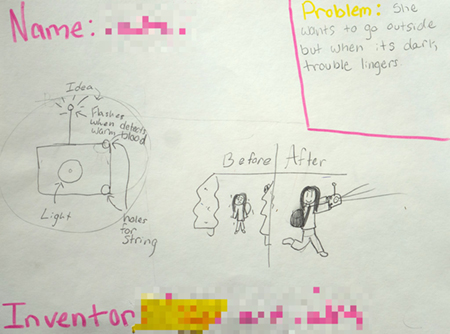
Figure 5. P132’s sketch of a danger detection device: A youth, P132, made this sketch to communicate her idea for a danger detection device, her solution to a problem identified by another youth, P109. The before/after area of the sketch depicts P109 using the device - note her facial expressions.
Before, P109 appears visibly scared and lonely, but after, P109 appears to be running forward with a confident smile on her face with P132’s invention in hand. Details in P132’s sketch express an understanding of P109’s problem that goes well beyond what P109 presented—facial expressions of fear before P132’s solution, an assumption that what causes P109’s fear has warm blood (i.e., is human), an assumption about how P109 wants to feel in the future, and a projection of how P109 will behave differently with P132’s solution. For P132 to be able to design her solution for P109, she had to connect—empathize—with P109’s situation to be able to imagine how P109 would like to feel in the future, then create something to contribute or cause P109’s change in emotion and behavior. The connection P132 expressed is essential in design-based making, as it allows people to extend their creative problem-solving efforts to focus on the needs of others, then contribute by creating a solution.
Let’s move to another example of how the same youth, P132, expresses the 6Cs connection and contribution through her design-based making, but this time for an adult staff member instead of a peer. Design artifacts—two sketches and two prototypes (Figures 6, 7)—detail an idea called bracelet key, designed to solve a bathroom keys problem originally identified by a member of the BGCCO staff.
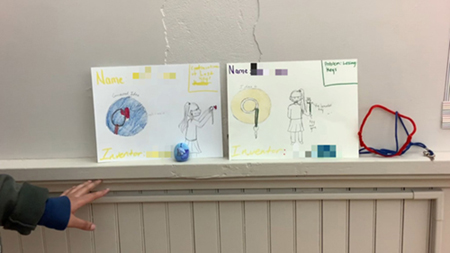
Figure 6. P132 presents concepts for a bracelet key: A youth, P132, made these sketches and prototypes to communicate her ideas for a system for other youth to use and return bathroom keys, which are frequently lost, according to a BGCCO staff member, P114.
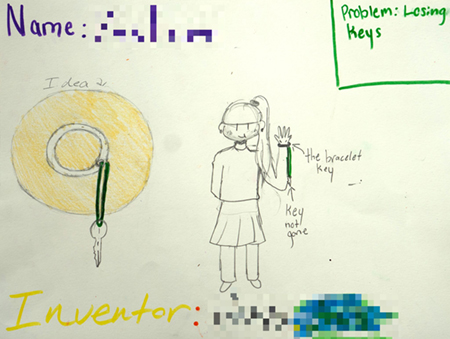
Figure 7. A close-up of P132’s sketch.
In her sketch presentation (Figures 6, 7), P132 describes her solution for the BGCCO staff member using her sketches and prototypes. Her idea is to keep bathroom keys highly visible and accessible to youth by attaching a large, rigid hoop to each bathroom key, which would allow the key to be worn as a bracelet and thus prevent the key from fitting into and being forgotten in a pants or jacket pocket. Additionally, P132 suggests placing hooks into each bathroom and by the front desk, providing a place for keys to live while in use or in waiting.
In her presentation, P132 expresses connection to P114 and other BGCCO staff and youth impacted by the problem P114 identified: P132 may have understood the frustration of staff about missing keys, the guilt or shame of youth who were blamed for losing keys unintentionally; then P132 expressed contribution as she proposed a solution to alleviate those negative feelings and replace them with feelings of thankfulness (staff), pride and responsibility (youth). Thus, P132’s presentations provide a glimpse of how she accomplished the PYD goal of expressing connection, and contribution through her design-based making.
Sub-theme 1C: Our Solution—Multimodal Communication through Design Artifacts
Our inside-out analysis revealed a dimension of the prevalent link between design-based making and expressions of the 6Cs of connection and contribution (Figure 1): multimodal communication, afforded by design artifacts (Figure 8).
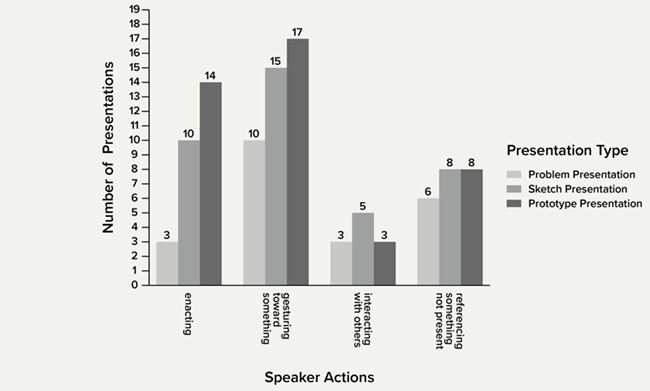
Figure 8. Design Presentation vs. Speaker Actions: Numeric values represent the total number of youth presentations wherein a particular speaker’s action occurred at least once. Bar colors correspond to the presentation type. Problem presentations are light gray; sketch presentations are medium gray; and prototype presentations are dark gray.
Across all three presentation types, inductive coding of youths’ physical movements indicates a pattern of youth gesturing toward something—commonly a design-based artifact—while speaking. Another pattern is that more youth enact or gesture toward something during sketch (10 enact, 15 gesture) and prototype (14 enact, 17 gesture) presentations, which occur during sequentially later design and develop phases, than they do while giving a problem (3 enact, 10 gesture) presentation (which generally didn’t include an artifact). Youth mostly presented their own work individually, with team presentations accounting for the bulk of presentations (11) interacting with others. Nonetheless, youths’ design-based artifacts helped them to express connection and contribution multimodally, opening the door to future exploration into design-based making’s link to the extensive literature on communication modalities. Two examples follow, pairing video stills with transcription (Figures 9, 10; Tables 8, 9).
In my chips design project (Figure 9; Table 8), youth P107 creates a chip duplicator to prevent people from taking her chips during lunch at school. In addition to gesturing toward her sketch, P107 also enacts her concept by demonstrating hand motions a user would have to perform while duplicating chips (pictured). During her prototype presentation for my chips, P107 gestures toward a 3D model.
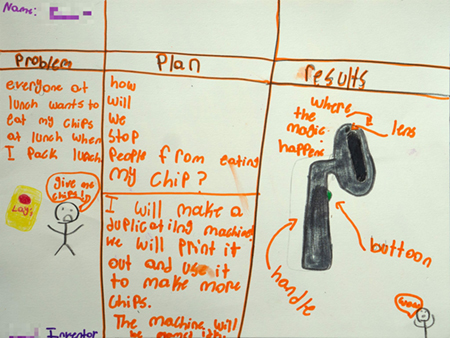
Figure 9. P107’s sketch of a chip duplicator, a generous solution to share a scarce lunchtime commodity.
Table 8. P107’s sketch and prototype presentations for my chips design project.
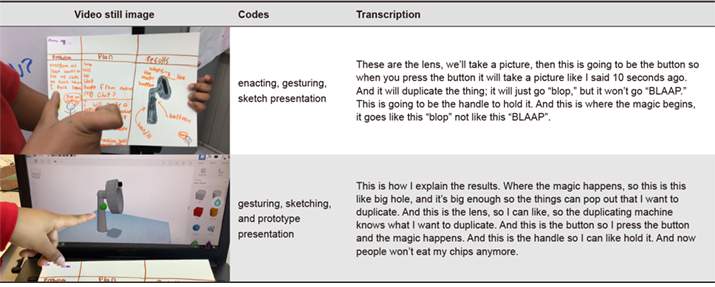
The second example (Figure 10; Table 9) is a design project called glitter container. P111 presents her device that vacuums glitter from surfaces and then funnels glitter back into its original container. While presenting her physical prototype, P111 enacts her solution by demonstrating a functional aspect of her prototype while saying few words. While presenting her 3D model prototype, P111 uses enacting once again to demonstrate how a user would interact with her solution.
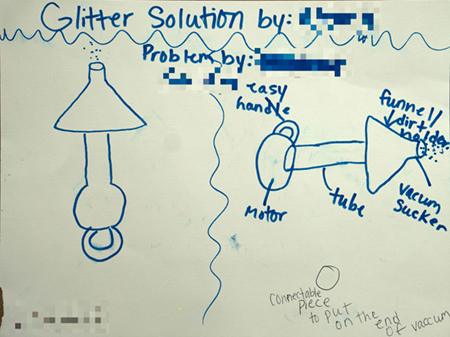
Figure 10. P111’s sketch of a glitter container that can vacuum and reuse glitter in the BGCCO art room, a problem identified by another youth, P109.
Table 9. P111’s prototype presentations for a glitter container.

By utilizing words in conjunction with visuals and actions, youths’ presentations are multimodal, suggesting design-based making enhanced youth communication, deepening expressions of the 6Cs of connection and contribution.
Sub-theme 1D: Our Design Project—Connections to the 6Cs of PYD and Self-efficacy
In this sub-theme, we present an overview of all of P132’s presentations to highlight findings from our outside-in analysis, which used deductive coding to find evidence for design-based making fostering self-efficacy and the 6Cs of PYD at an individual level. Table 10 presents video stills in chronological order from each of P132’s problem, sketch, and prototype presentations alongside a series of binary presence or absence indicators, which were derived from deductive coding of each presentation related to self-efficacy—through archetypal experience and particularized categories—and PYD - through the 6Cs.
Table 10. P132’s video presentations and coded links to self-efficacy and PYD.
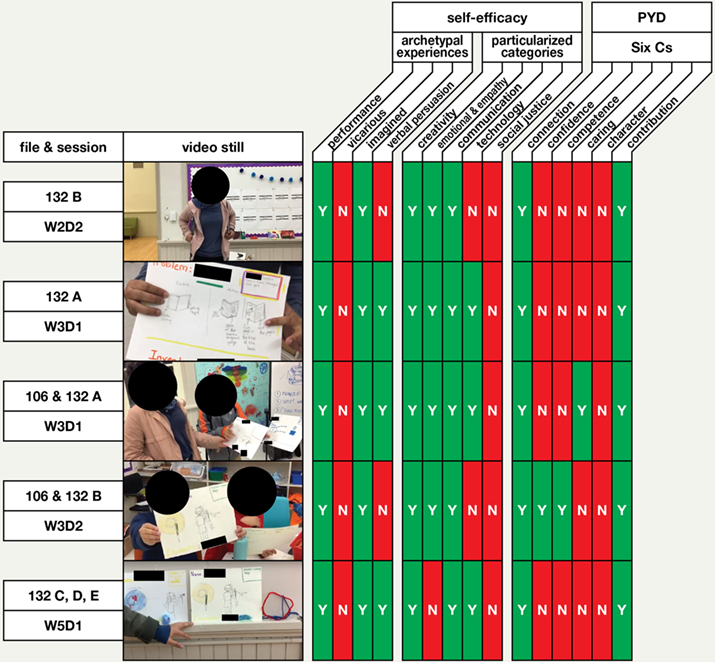
Table 10 shows that each of P132’s presentations served as archetypal performance and imagined experiences that foster self-efficacy. To expand on this, when viewed through the lens of self-efficacy, P132’s presentations were performance experiences because she demonstrated her successful completion of a programming challenge. Contained within P132’s presentations are sketches and prototypes of ideas for things that did not yet exist; as they are solutions to problems, they can be interpreted as imagined experiences for future success. As archetypal experiences, her presentations were thus opportunities to foster her self-efficacy related to the tasks she was presenting or performing, shown in Table 10 as related to the particularized self-efficacies of communication, emotional and empathy, and creativity.
While findings did not reveal an explicit connection in P132’s presentations to archetypal vicarious experiences (Table 10), this does not necessarily indicate a missing link between vicarious experience and design-based making. On the contrary, the fact that youths’ presentations—and therefore their performance and imagined experiences—were captured and shared in video recordings each time a youth watched a peer’s presentation can be interpreted as a vicarious experience, thus another opportunity to foster their self-efficacy. Moreover, design-based artifacts may be understood as embodiments of imagined experience, persistent from session to session as sketches and prototypes, thus providing youth-artifact interactions that can be understood as vicarious experiences.
In summary, presentations from P132 and others in her network provide an individual-level look into the nature of the links between design-based making, PYD, and youth self-efficacy, highlighted in Figures 1, 2, and 3.
Primary Theme 2: Design Facilitates an Emergent Network of Contribution
While the previous primary theme and sub-themes presented individual-level findings, the second primary theme and its sub-themes showcase the emergence of and extent to which youth expressed the 6Cs of connection and contribution from a program-level perspective. 26 youths from two age groups attended 12 program sessions over 6 thematic weeks alongside 6 adult volunteers and staff. 22 youth and 4 adult participants identified 33 problems from their own lives and surroundings, then used design-based making to create 45 artifacts, which they presented in 78 video-recorded sessions shared with peers.
Model 2A: A Network Emergence Diagram and its Contents
While analyzing research data from the inside-out, it became apparent that a network had emerged during the Improve Our Club! program, connecting BGCCO youth with staff and volunteers via design-based artifacts such as sketches and prototypes. During outside-in analysis, this emergent network took on additional relevance to the research questions because of the importance of relationships and interactions between youth as they expressed PYD 6Cs’ connection, caring, and contribution. However, inside-out and outside-in thematic analysis provided an individual-level view that did not seem to capture the network’s complexity or meaning from a program-level perspective. Thus, searching for and creating a new sense-making tool was necessary to uncover when relationships between people occurred, how they were related to design-based making and PYD goals, and the extent of connection across the entire program.
Figure 11 presents a new sense-making tool resulting from our exploratory analysis: a network emergence diagram, documented further in Appendix A. While it does not show everything that happened during the program—no single diagram could—it does visualize the program-level complexity behind Improve Our Club! and it will serve as a reference throughout these thematic findings.
Figure 11. Network emergence diagram of the Improve Our Club!—final state. (Click to see the larger image.)
A critical feature of Figure 11 is that a series of chronological snapshots comprise its final state. By viewing snapshots in chronological order (viewable animation at https://go.osu.edu/ijd-making-for-one-another-figure11), one can see how people, design projects, and relationships emerged within Improve Our Club! over its 12 sessions.
Sub-theme 2B: Youth Adapt Design-based Making to Fit Their Projects
Characterized as three presentation types (Figures 1, 2, 3), and two emergent relationships (Figure 11), the diversity contained across the whole of youth design-based making might be lost. Network emergence mapping afforded a direct comparison between projects, revealing that although youth made many of the same types of design-based artifacts, the chronological order and quantity of artifacts made for any particular design project varied (see Appendix B). In other words, youth engaged in design-based making in an order that made the most sense to them and their design project, a nuance to how design-based making promotes PYD goals.
From this program-level insight, we can dive into individual-level examples. Figure 12 includes photographs of multiple sketches and prototypes made by a single youth, P110, throughout several program sessions for the project paint bottle.
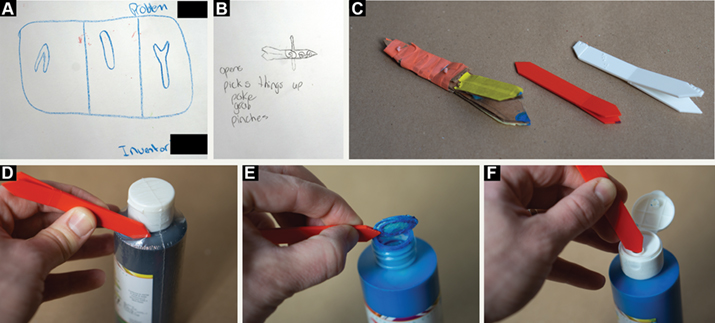
Figure 12. Design-based artifacts for a paint bottle: (a) sketch close-up (b) sketch (c) prototypes (d)(e)(f) sequence of use.
In Figure 12, photo A shows how P110 sketched three ideas for a tool that would be useful to open a new bottle of paint ordinary to the BGCCO art room. Photo B shows a second sketch wherein P110 combined functional aspects from each idea in photo A. Photo C shows three prototypes, P110 created based on the sketch in photo B; the prototype on the left in photo C was made first, allowing P110 to test the scale and shape of his idea; however, the cardboard was not strong enough to perform the proposed function. The prototype in the center of photo C is a 3D print of a model the youth created. It is also shown in photos D, E, and F performing the proposed functions to break and remove a paint bottle’s wrapper, peel off a seal without getting a user’s fingers dirty, and then clear out a clogged bottle nozzle. The prototype on the right in photo C is a third prototype, also 3D modeled and 3D printed, which included modifications based on testing the second prototype.
P110’s use of design-based making, exemplified in Figure 12, to propose, present, test, and make changes to a concept was common in design-based making found in other design projects, especially those where multiple design-based artifacts emerged over time. This provides an individual-level view of how youth engaged in design-based making over Improve Our Club! to complement the program-level understanding of how youths adapted design-based making to fit their projects over time.
Figure 13 provides another example of design-based making iteration from another youth, P111, who worked on the design project glitter container.

Figure 13. Design-based artifacts for a glitter container: (a) sketch, (b) prototype, and (c) prototype.
In Figure 13, photo A contains P111’s sketch of her solution for the glitter container, which she later prototyped using art supplies, as seen in photo B. Several functional additions can be seen in B, including buttons, two funnels of different sizes, and decorative elements. P111’s third prototype, presented in photo C, was 3D printed and includes modifications to her solution’s scale, location of functional elements such as a power switch and battery back, and the inclusion of an additional funnel nozzle and cap. P111 presented both prototypes in videos, demonstrating the functional aspects of her solution.
In highlighting youth making across multiple program sessions in relation to artifact materiality and concept refinement through iteration, P110 and P111 demonstrate how they adapted design-based making to match their projects. Ways in which program delivery can adapt to youth participants are of interest to PYD practitioners and researchers as a means to meet the needs of unique communities.
Sub-theme 2C: Design-based Making Facilitates Asynchronous Collaboration
Improve Our Club! program activities challenged youth to solve problems for others and make things for one another. As they did so, some youth formed groups to work toward a solution—sometimes synchronously, others asynchronously. This was important for Improve Our Club! for two reasons: one, this allowed youth with sporadic attendance to engage with design-based making and express the 6Cs of PYD—specifically connection and contribution whenever they could attend; and two, it allowed the general sequence of design-based making to be adapted to a specific youth’s needs while still permitting collaboration among youth.
By isolating the people in Figure 11 who worked on the glitter container showcased in Figure 13, the design project with the most design-based artifacts contributed to it over time, we can see how youth contributed their solutions asynchronously. Figure 14 shows the final state of the network of people connected to the glitter container, viewable as an animation at https://go.osu.edu/ijd-making-for-one-another-figure14 and frame-by-frame in Appendix B.
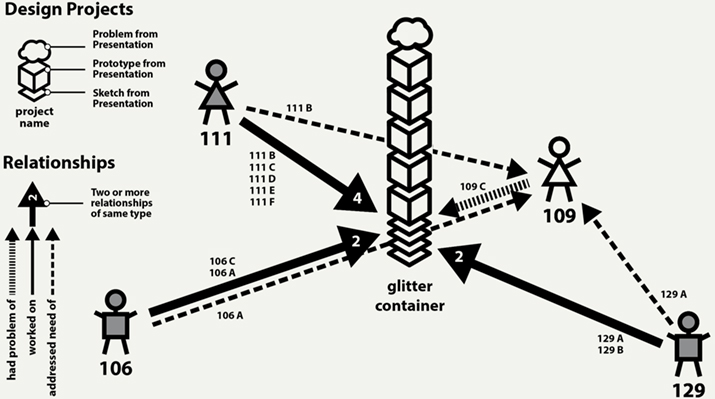
Figure 14. Egocentric network emergence diagram—The glitter container design project, final state.
Youth who worked on the glitter ccontainer did not always attend the same sessions. Nevertheless, they used design-based making to add sketches and prototypes to the design project, addressing P109’s needs throughout 4 program sessions. Youths’ presentations of their design-based artifacts and the artifacts themselves remained in the Improve Our Club! room from session to session, accessible to all youth working on the same design project. Thanks to its artifacts and the way youth presented their work, design-based making permitted youth to express the 6Cs of PYD asynchronously, further demonstrating how design-based making accomplishes PYD program goals.
Additional Discussion
Overall, findings strongly indicate that a PYD program can instrumentalize design-based making to foster the positive development of youth—beyond learning—through (i) structuring program activities around design-based making fundamentals, offering youth (ii) opportunities to express the 6Cs of PYD and boost particularized self-efficacies linked with designing as related to archetypal experiences for fostering self-efficacy. Additionally, findings reveal themes expressing the nuance with which (iii) design-based making fosters youth development at the individual level and programmatic level.
On Design-based Making Fundamentals and PYD Program Structure
Findings provide a granular look into how youth employed design-based making within a PYD program structure. Our study points toward what may be considered fundamentals of designing within PYD: youth making was structured as design challenges aiming to connect youth with their worlds and cohabitants holistically across multiple activities; the purpose of youth making was to solve problems for others, then envision and communicate their ideas; youth iteratively made multiple artifacts with different forms (e.g., sketch, prototype) in the process of designing an idea that co-evolved with their understanding of someone else’s problem. Each step afforded youth different opportunities to express a different set of the 6Cs (Figure 1) and particularized self-efficacies (Figure 3). More research is needed to understand further the advantages and limitations of design-based making, in its myriad forms, in PYD programs and how it might be best adapted to program delivery, especially compared to other forms of making.
Findings indicate that youth augment their communication with design-based artifacts; youth multimodally show, tell, and demonstrate their ideas, even when their ideas appear in a rough sketch or prototype form. This may allow for a deeper understanding of problems and potential solutions to be communicated to and understood by PYD program participants and providers alike, as communication tools, design-based artifacts—often rough and imprecise representations—effectively allowed youth to express their thoughts and ideas, and visions for the future to their peers. Underserved youth targeted by PYD programs might benefit from having non-written and non-verbal ways of communication. Especially when lower-than-average reading levels and verbal language present communication challenges, two-dimensional (e.g., sketches) and three-dimensional (e.g., prototypes) design-based artifacts may expand youths’ capacity to communicate their ideas and understand others’ ideas.
On the 6Cs of PYD
At the individual level, findings link design-based making activities and youth expressions of the 6Cs of PYD, most strongly connection and contribution, and to a lesser extent competence, confidence, character, and caring. Stronger support for contribution than the other Cs might surprise PYD scholars because the so-called Sixth C of contribution emerges only in the presence of the other 5Cs (King et al., 2005; Lerner et al., 2015). In one sense, these findings may challenge the notion that the other 5Cs are necessary for contribution to occur in a PYD program setting. In another sense, findings may suggest that design-based making is a shortcut to contribution. Alternatively, findings may suggest the 5Cs were present but went undetected by the research method, thereby positioning contribution through design-based making as a validation measure for the 5Cs in PYD program delivery. Or, perhaps findings indicate that the 6Cs model only accounts for the epistemologies of arts-based and sciences-based making in PYD programs, suggesting the 6Cs model, specifically the causal and directional relationship between contribution and the other Cs, needs to be reexamined; does design-based making start with contribution? Do confidence, competence, connection, caring, and character follow?
Our social network analysis revealed a complex web of connections between program participants emerged over time; design projects, encapsulated in youth presentations of their design-based making, afforded youth opportunities to connect with and contribute to one another, addressing the needs of others despite inconsistent program attendance and participant demographics. Viewed as a whole, the Network Emergence Diagram for Improve Our Club! serves to express a unique and situated expression of contribution within a community of practice.
On Self-efficacy
By examining PYD program activities featuring design-based making through the lens of self-efficacy, linking youths’ design-based making with archetypal experiences (Figure 2) and with particularized self-efficacies (Figure 3), this study set the stage for establishing a particularized measure of design self-efficacy (DSE). Particularized self-efficacies selected and analyzed in this study have criterial tasks overlapping those Chien et al. (2022) identified as common in industrial design. However, this study stops short of establishing criterial tasks specific to design, a required step in establishing a particularized measure of design self-efficacy as described by Bandura (1997, 2006) and Pajares (1996). Having a standard measure of design self-efficacy would address an assessment gap in design, as called for by Cross (2018) and Manzini (2016), possibly relevant as an assessment tool for design education programs or an indicator of readiness to enter the design workforce. Future work on establishing DSE would need to account for the changing correlation between particularized self-efficacies across design activities indicated in Figure 3.
Conclusion
Free the child’s potential, and you will transform them into the world, a common paraphrase widely attributed to groundbreaking educator and innovator Maria Montessori (e.g., 1948) epitomizes a view long held by educators: youths are creative, capable, and pivotal in shaping the future. We agree; this research unveils an impactful convergence of design-based making and Positive Youth Development (PYD), positioning design as an avenue to unleash youths’ potential beyond learning as well as a means for youth to contribute to their world.
Pragmatically, doing design fosters youth development. This study expands upon design’s established role in the development of youth, moving beyond design’s role as a learning aid in design-based learning (DBL) education frameworks. Design, as viewed through Positive Youth Development, affords youth opportunities to express the 6Cs of PYD. Youth identified problems in their lives and envisioned solutions for others’ problems through sketching and prototyping. Notably, as they envisioned solutions to issues identified by their peers, youth most frequently expressed the 6Cs of connection with and contribution to other youth and adults in the program, as well as their own immediate surroundings, neighborhood, and community; as viewed through the lens of PYD, this study signifies a pivotal step in understanding design as a contributor to youth development. Moreover, this study provides evidence that different phases of design-based making support different PYD goals at different times, suggesting design might offer a holistic approach to making in PYD. Future PYD programs might integrate design-based making by adopting a similar structure to the one shared here, featuring: a challenge-based activity approach; problem identification, sketching and prototyping activities; a mechanism for youth to capture and share their work in video-recorded presentations. Additionally, network emergence mapping may play a diagnostic role for PYD providers or design practitioners tasked with engaging program stakeholders, showing which projects and individuals are more connected than others.
Epistemically, as youth design, our understanding of the world evolves. Youth solved problems for others in the material world as they modeled and synthesized problem statements, sketches, and prototypes. Thanks to Cross’s (1982) articulation of the designerly way, we can understand that youth designed despite no formal design education. They discovered and defined problems with which they had a personal connection in their homes, schools, neighborhoods, and the South Side Club, then created solutions for one another as they made and shared sketches and prototypes of their ideas. In this sense, design-based making mobilized in a PYD program provides an actionable look into the lives and understandings of youth. Planners, policy-makers, and other designers would be wise to incorporate youth voices into their work, understanding youth’s lived realities vis-a-vis their design-based making to build more appropriate, situated design solutions. This study suggests that design, particularly as situated in youth programs, holds the potential to redefine its role and impact not as a paradigm shift but as a valuable avenue for positive societal outcomes and expanded epistemic realms—design might invest in PYD as a new practice area, and in youth as designers capable of expanding our collective understanding of the material world, as it is today and as it might be tomorrow. Additionally, as youth design-based making afforded youth to express contribution, this study provides evidence that the current 6Cs model of PYD needs to be updated to account for design-based making, suggesting further work will be needed to directly compare the relative priorities of the “Cs” across the three types of making.
This research highlights how design-based making can be integrated into youth development programs to support personal growth and social engagement. By leveraging design practices—specifically design-based making—this study positions design as a tool to examine and foster connection across a network of individuals and afford youth an avenue to contribute to the design of their world, expanding design’s role beyond traditional educational contexts.
Acknowledgments
Thank you to the youth, staff, and volunteers at the South Side Club of the Boys & Girls Clubs of Central Ohio; to Kris Kling, Todd Perkins, and the volunteers from Local Tech Heroes; to the IJD reviewers for their thorough and thoughtful comments; and, to The Ohio State University whose University Fellowship afforded the lead author time and means to complete this work.
Ethics Review
This study gained IRB approval at The Ohio State University.
References
- Anyon, Y., & Jenson, J. M. (2014). Positive youth development. In E. Mullen (Ed.), Oxford bibliographies in social work. Oxford University Press. https://doi.org/10.1093/obo/9780195389678-0145
- Bacigalupo, M., Kampylis, P., Punie, Y., & Van den Brande, G. (2016). EntreComp: The entrepreneurship competence framework. https://core.ac.uk/download/pdf/38632642.pdf
- Ball, L. J., & Christensen, B. T. (2018). Designing in the wild. Design Studies, 57, 1-8. https://doi.org/10.1016/j.destud.2018.05.001
- Bandura, A. (1977). Self-efficacy: Toward a unifying theory of behavioral change. Psychological Review, 84(2), 191-215. https://doi.org/10.1037/0033-295X.84.2.191
- Bandura, A. (1986). Social foundations of thought and action: A social cognitive theory. Prentice-Hall.
- Bandura, A. (1997). Self-efficacy: The exercise of control. W. H. Freeman.
- Bandura, A. (2006). Guide for constructing self-efficacy scales. In F. Pajares & T. Urdan (Eds.), Self-efficacy beliefs of adolescents (pp. 307-337). Information Age.
- Bedford, D. A. D., Arns, J. W., & Miller, K. (2017). Unpacking a design thinking process with discourse and social network analysis. In B. T. Christensen, L. J. Ball, & K. Halskov (Eds.), Analysing design thinking: Studies of cross-cultural co-creation (pp. 349-370). CRC Press. https://doi.org/10.1201/9781315208169
- Beghetto, R. A. (2006). Creative self-efficacy: Correlates in middle and secondary students. Creativity Research Journal, 18(4), 447-457. https://www.tandfonline.com/doi/abs/10.1207/s15326934crj1804_4
- Benson, P. L., Scales, P. C., Hamilton, S. F., & Sesma Jr., A. (2006). Positive youth development: Theory, research, and applications. In W. Damon & R. M. Lerner (Eds.), Handbook of child psychology (6th ed., Vol. 1, pp. 895-941). John Wiley & Sons.
- Bevan, B., Ryoo, J., & Shea, M. (2017). What if? Building creative cultures for STEM making and learning. Afterschool Matters, 25, 1-7.
- Braun, V., & Clarke, V. (2006). Using thematic analysis in psychology. Qualitative Research in Psychology, 3(2), 77-101. https://doi.org/10.1191/1478088706qp063oa
- Carberry, A. R., Lee, H. S., & Ohland, M. W. (2010). Measuring engineering design self-efficacy. Journal of Engineering Education, 99(1), 71-79. https://doi.org/10.1002/j.2168-9830.2010.tb01043.x
- Catalano, R. F., Berglund, M. L., Ryan, J. A., Lonczak, H. S., & Hawkins, J. D. (2002). Positive youth development in the United States: Research findings on evaluations of positive youth development programs. The ANNALS of the American Academy of Political and Social Science, 591(1), 98-124. https://doi.org/10.1177/0002716203260102
- Chien, Y.-H., Lin, K.-Y., Hsiao, H.-S., Chang, Y.-S., & Chan, S.-C. (2022). Measuring industrial design self-efficacy and anxiety. International Journal of Technology & Design Education, 32, 1317-1336. https://doi.org/10.1007/s10798-020-09648-0
- Christensen, B. T., Ball, L. J., & Halskov, K. (2017). Analysing design thinking: Studies of cross-cultural co-creation. CRC Press. https://doi.org/10.1201/9781315208169
- Chu, S. L., Quek, F., Bhangaonkar, S., Ging, A. B., & Sridharamurthy, K. (2015). Making the maker: A means-to-an-ends approach to nurturing the maker mindset in elementary-aged children. International Journal of Child-Computer Interaction, 5, 11-19. https://doi.org/10.1016/j.ijcci.2015.08.002
- Collaborative for Academic, Social, and Emotional Learning. (2019). Core SEL competencies. https://casel.org/core-competencies/
- Corbin, J., & Strauss, A. (2014). Basics of qualitative research: Techniques and procedures for developing grounded theory. Sage. https://doi.org/10.4135/9781452230153
- Crismond, D. P., & Adams, R. S. (2012). The informed design teaching and learning matrix. Journal of Engineering Education, 101(4), 738-797. https://doi.org/10.1002/j.2168-9830.2012.tb01127.x
- Cross, N. (1982). Designerly ways of knowing. Design Studies, 3(4), 221-227. https://doi.org/10.1016/0142-694X(82)90040-0
- Cross, N. (2018). Developing design as a discipline. Journal of Engineering Design, 29(12), 691-708. https://doi.org/10.1080/09544828.2018.1537481
- Davis, M. (1998). Making a case for design-based learning. Arts Education Policy Review, 100(2), 7-15. https://doi.org/10.1080/10632919809599450
- Davis, M., Hawley, P., McMullan, B., & Spilka, G. (1997). Design as a catalyst for learning. Association for Supervision and Curriculum Development.
- Design Council. (2019). Framework for innovation. https://www.designcouncil.org.uk/our-resources/framework-for-innovation/
- Deutsch, N. L, Blyth, D. A., Kelley, J., Tolan, P. H., & Lerner, R. M. (2017). Let’s talk after-school: The promises and challenges of positive youth development for after-school research, policy, and practice. In N. L. Deutsch (Ed.), After-school programs to promote positive youth development: Integrating research into practice and policy (Vol. 1, pp. 45-68). Springer. https://doi.org/10.1007/978-3-319-59132-2_4
- Dilnot, C. (1982). Design as a socially significant activity: An introduction. Design Studies, 3(3), 139-146. https://doi.org/10.1016/0142-694X(82)90006-0
- Doppelt, Y., Mehalik, M. M., Schunn, C. D., Silk, E., & Krysinski, D. (2008). Engagement and achievements: A case study of design-based learning in a science context. Journal of Technology Education, 19(2), 22-39. https://jte-journal.org/articles/10.21061/jte.v19i2.a.2
- Dow, S. P., Glassco, A., Kass, J., Schwarz, M., Schwartz, D. L., & Klemmer, S. R. (2010). Parallel prototyping leads to better design results, more divergence, and increased self-efficacy. In H. Plattner, C. Meinel, & L. Leifer, (Eds.), Design thinking research (pp. 127-153). Springer. https://doi.org/10.1007/978-3-642-21643-5_8
- Dutton, S. E. (2001). Urban youth development–Broadway style: Using theatre and group work as vehicles for positive youth development. Social Work with Groups, 23(4), 39-58. https://doi.org/10.1300/J009v23n04_04
- Ersing, R. L. (2009). Building the capacity of youths through community cultural arts: A positive youth development perspective. Best Practice in Mental Health, 5(1), 26-43. https://doi.org/10.70256/339564iiuqdz
- Fereday, J., & Muir-Cochrane, E. (2006). Demonstrating rigor using thematic analysis: A hybrid approach of inductive and deductive coding and theme development. International Journal of Qualitative Methods, 5(1), 80-92. https://doi.org/10.1177/160940690600500107
- Gaffney, A. L. H. (2011). Measuring students’ self-efficacy for communication. International Journal of Art & Design Education, 30(2), 211-225. https://doi.org/10.1111/j.1476-8070.2011.01702.x
- Gómez Puente, S. M., van Eijck, M., & Jochems, W. (2011). Towards characterising design-based learning in engineering education: A review of the literature. European Journal of Engineering Education, 36(2), 137-149. https://doi.org/10.1080/03043797.2011.565116
- Guersenzvaig, A. (2021). The goods of design: Professional ethics for designers. Rowman & Littlefield.
- Interagency Working Group on Youth Programs. (2020). Positive youth development. https://web.archive.org/web/20250124030405/https://youth.gov/youth-topics/positive-youth-development
- Janzer, C. L., & Weinstein, L. S. (2014). Social design and neocolonialism. Design and Culture, 6(3), 327-343. https://doi.org/10.2752/175613114X14105155617429
- Jobst, B., Köppen, E., Lindberg, T., Moritz, J., Rhinow, H., & Meinel, C. (2012). The faith-factor in design thinking: Creative confidence through education at the design thinking schools Potsdam and Stanford? In M. Christoph & L. Leifer (Eds.), Design thinking research (pp. 35-46). Springer. https://doi.org/10.1007/978-3-642-31991-4_3
- King, P. E., Dowling, E. M., Mueller, R. A., White, K., Schultz, W. Osborn, P., Dickerson, E. Bobke, D. L., Lerner, R. M., Benson, P. L., & Scales, P. C. (2005). Thriving in adolescence: The voices of youth-serving practitioners, parents, and early and late adolescents. Journal of Early Adolescence, 25(1), 94-112. https://doi.org/10.1177/0272431604272459
- Kirk, B. A., Schutte, N. S., & Hine, D. W. (2008). Development and preliminary validation of an emotional self-efficacy scale. Personality and Individual Differences, 45(5), 432-436. https://doi.org/10.1016/j.paid.2008.06.010
- Lee, H. K., & Breitenberg, M. (2010). Education in the new millennium: The case for design-based learning. International Journal of Art & Design Education, 29(1), 54-60. https://doi.org/10.1111/j.1476-8070.2010.01631.x
- Lerner, R. M. (2005). Promoting positive youth development: Theoretical and empirical bases. https://starfinderfoundation.org/wp-content/uploads/2015/04/PYDWhitePaper.pdf
- Lerner, R. M., Almerigi, J. B., Theokas, C., & Lerner, J. V. (2005). Positive youth development a view of the issues. The Journal of Early Adolescence, 25(1), 10-16. https://psycnet.apa.org/doi/10.1177/0272431604273211
- Lerner, R. M., Lerner, J. V., Almerigi, J., Theokas, C., Naudeau, S., Gestsdottir, S., Naudeau, S., Jelicic, H., Alberts, A., Ma, L., Smith, L., Bobek, D., Richman-Raphael, D., Simpson, I., Christiansen, E. D., & von Eye, A. (2005). Positive youth development, participation in community youth development programs, and community contributions of fifth grade adolescents: Findings from the first wave of the 4-H study of positive youth development. Journal of Early Adolescence, 25(1), 17-71. https://doi.org/10.1177/0272431604272461
- Lerner, R. M., Lerner, J. V., Bowers, E. P., & John Geldhof, G. (2015). Positive youth development and relational-developmental-systems. In R. M. Lerner (Ed.), Handbook of child psychology and developmental science (pp. 1-45). John Wiley & Sons. https://doi.org/10.1002/9781118963418.childpsy116
- Lin, F. L. Y. (2019). Using thematic analysis to facilitate meaning-making in practice-led art and design research. International Journal of Art & Design Education, 38(1), 153-167. https://doi.org/10.1111/jade.12177
- Local Tech Heroes (2019). LTH announces six-week improve our club! program with boys & girls clubs of Columbus. http://web.archive.org/web/20200606162213/https://www.localtechheroes.org/news
- Local Tech Heroes. (2020). LTH improve our club!. https://sites.google.com/localtechheroes.org/lth/programs/lth-improve-our-club
- Mace, M. A., & Ward, T. (2002). Modeling the creative process: A grounded theory analysis of creativity in the domain of art making. Creativity Research Journal, 14(2), 179-192. https://doi.org/10.1207/S15326934CRJ1402_5
- Maddux, J. E., & Kleiman, E. M. (2016). Self-Efficacy: A foundational concept for positive clinical psychology. In A. M. Wood & J. Johnson (Eds.), The Wiley handbook of positive clinical psychology (pp. 89-101). John Wiley & Sons. https://psycnet.apa.org/doi/10.1002/9781118468197.ch7
- Maddux, J. E., Kleiman, E., & Gosselin, J. T. (2011). Self-efficacy. In D. S. Dunn (Ed.), Oxford bibliographies in psychology. Oxford University Press.
- Major, J. C., Carberry, A. R., & Kirn, A. N. (2020). Revisiting a measure of engineering design self-efficacy. International Journal of Engineering Education, 36(2), 749-761.
- Manzini, E. (2016). Design culture and dialogic design. Design Issues, 32(1), 52-59. https://doi.org/10.1162/DESI_a_00364
- Margolin, V., & Margolin, S. (2002). A “social model” of design: Issues of practice and research. Design Issues, 18(4), 24-30. https://doi.org/10.1162/074793602320827406
- Meschke, L. L., Peter, C. R., & Bartholomae, S. (2012). Developmentally appropriate practice to promote healthy adolescent development: Integrating research and practice. Child & Youth Care Forum, 41(1), 89-108. https://doi.org/10.1007/s10566-011-9153-7
- Montessori, M. (1948). The discovery of the child (M. A. Johnstone, Trans.). Kalakshetra Publications.
- Muratovski, G. (2015). Paradigm shift: Report on the new role of design in business and society. She Ji: The Journal of Design, Economics, and Innovation, 1(2), 118-139. https://doi.org/10.1016/j.sheji.2015.11.002
- Nhem, L. (2015). Teachers’ application of design-based learning principles toward creating a common core aligned curriculum [Unpublished doctoral dissertation]. California State Polytechnic University. https://scholarworks.calstate.edu/downloads/x633f331x
- Nickley, W. A. (2020). Making for one another: An exploration of design-based making in positive youth development program delivery [Unpublished master’s thesis]. The Ohio State University. http://rave.ohiolink.edu/etdc/view?acc_num=osu1594656061637407
- Nickley, W. A. (2021). Practices of making: Exploring design-based making within positive youth development. In M. Botta & S. Junginger (Eds.), Design as common good: Framing design through pluralism and social values (pp.1086-1106). SUPSI, HSLU, swissdesignnetwork. https://drive.switch.ch/index.php/s/92PEcA3qKVoXEDD
- Ohly, S., Plückthun, L., & Kissel, D. (2017). Developing students’ creative self-efficacy based on design-thinking: Evaluation of an elective university course. Psychology Learning & Teaching, 16(1), 125-132. https://doi.org/10.1177/1475725716681714
- Papanek, V. (1971). Design for the real world: Human ecology and social change. Pantheon.
- Pajares, F. (1996). Self-efficacy beliefs in academic settings. Review of Educational Research, 66(4), 543-578. https://doi.org/10.3102/00346543066004543
- Proulx, S. (2019). Questioning the nature of design activity, through Alasdair MacIntyre’s account of the concept of practice. The Design Journal, 22(5), 649-664. https://doi.org/10.1080/14606925.2019.1629775
- Rao, H., Puranam, P., & Singh, J. (2020). Does design thinking training really increase creativity? Results from an experiment with middle-school students (INSEAD Working Paper No. 2020/11/STR). Institut Européen d’Administration des Affaires. http://dx.doi.org/10.2139/ssrn.3543943
- Saldaña, J. (2015). The coding manual for qualitative researchers. Sage.
- Sanders, E. B.-N., & Stappers, PJ. (2012). Convivial toolbox: Generative research for the front end of design. Bis.
- Shank, D. B., & Cotten, S. R. (2014). Does technology empower urban youth? The relationship of technology use to self-efficacy. Computers & Education, 70, 184-193. https://doi.org/10.1016/j.compedu.2013.08.018
- The Center for City Building Education. (n.d.). What is design-based learning? https://www.designbasedlearning.org/what-we-do
- Tierney, P., & Farmer, S. M. (2002). Creative self-efficacy: Its potential antecedents and relationship to creative performance. Academy of Management Journal, 45(6), 1137-1148. https://doi.org/10.2307/3069429
- Torres-Harding, S. R., Siers, B., & Olson, B. D. (2012). Development and psychometric evaluation of the social justice scale (SJS). American Journal of Community Psychology, 50(1-2), 77-88. https://doi.org/10.1007/s10464-011-9478-2
- Tsang, S. K., Hui, E. K., & Law, B. (2012). Self-efficacy as a positive youth development construct: A conceptual review. The Scientific World Journal, 2012, Article No. 452327. https://doi.org/10.1100/2012/452327
- Usher, E. L., & Pajares, F. (2008). Sources of self-efficacy in school: Critical review of the literature and future directions. Review of Educational Research, 78(4), 751-796. https://doi.org/10.3102/0034654308321456
- Voigt, C., Unterfrauner, E., Aslan, T., & Hofer, M. (2019). Design thinking with children: The role of empathy, creativity and self-efficacy. In Proceedings of the 8th FabLearn conference on maker education (pp. 144-147). ACM. https://doi.org/10.1145/3311890.3311912
- Vongkulluksn, V. W., Matewos, A. M., & Sinatra, G. M. (2021). Growth mindset development in design-based makerspace: A Longitudinal study. The Journal of Educational Research, 114(2), 139-154. https://doi.org/10.1080/00220671.2021.1872473
- Vlahos, D. (2022). Design as a catalyst for empowerment: Lessons from youth design, a design-led after school program for high school students in Boston. Dialectic, 4(1). https://doi.org/10.3998/dialectic.14932326.0004.103
- Waid, J., & Uhrich, M. (2020). A scoping review of the theory and practice of positive youth development. The British Journal of Social Work, 50(1), 5-24. https://doi.org/10.1093/bjsw/bcy130
- Walker, S. (2004). Understanding the artmaking process: Reflective practice. Art Education, 57(3), 6-12. https://doi.org/10.1080/00043125.2004.11653545
- Wijnen, W. H. F. W., Delhoofen, P. J. W. M., & Mulders, D.-J. W. M. (Ed.) (2000). Towards design-based learning (Vol. 1). Technische Universiteit Eindhoven. https://research.tue.nl/en/publications/towards-design-based-learning
Appendix A: Additional Analysis Details
While a comprehensive analysis is provided by Nickley (2020, pp.77-84, 238-262), including thematic analysis memos, codebooks, diagrams, etc., selected analysis details are provided here.
Initial Data Exploration
Initially, analysis followed a workflow common to thematic analysis (Braun & Clarke, 2006; Fereday & Muir-Cochrane, 2006) and grounded theory (Corbin & Strauss, 2014; Saldaña, 2015). Audio and video recorded data were transcribed, physical items were photographed, and all data were compiled into a digital data corpus. The entire data corpus was imported into NVivo 12 Plus, a computer application designed to facilitate qualitative analysis, specifically analytical approaches involving coded analysis as found in thematic analysis. People and design projects were tracked as cases, and relationships were added between cases based on design-based making activities.
“Inside-out”
A first round of analysis employed a combination of inductive coding methods, following what Christensen et al. (2017) refer to as an inside-out approach. This exploratory process began with Braun and Clarke’s (2006) first phase of thematic analysis—familiarizing with the data—and continued through phases two to five, as codes and themes emerged, were reflected upon, adjusted, and reapplied. The goal, guided by Sanders and Stappers’ (2012) model based on Ackoff’s DIKW scheme, was to transform data into information. Drawing inspiration from Lin’s (2019) thematic analysis of artifacts, the inside-out method also incorporated qualitative observations and inductive coding, as seen in prior analyses of DTRS11 data (Christensen et al., 2017).
The inside-out analysis process began with an initial pass through the data, where all items were read, listened to, or viewed, and detailed notes were recorded. This step generated a set of initial ideas, including potential themes, qualitative observations, and possible codes. Following this, a concept map was created to visually organize these ideas, color-coded based on their origin in specific data sets. The map highlighted three distinct areas within the data, referred to as data super-sets (DSSs). The initial ideas were then rearranged and grouped with similar concepts, with additional connections made and redundant elements identified. This resulted in a more structured map, with thematic ideas and codes organized hierarchically around emerging categories. A coding check was conducted next, where the initial codes were applied to the full data set and evaluated for their relevance to the research questions. The prioritized codes and themes were then visually organized into a final map, allowing for clear identification of key areas. These prioritized codes informed the development of an inductive codebook, which guided subsequent coding across the relevant data sets in several passes, with adjustments made as needed during the process.
“Outside-in”
In contrast to the inside-out analysis, a second round of analysis followed a deductive coding approach, referred to as working from the outside-in. This approach drew on established theories from Positive Youth Development (PYD) through the Six Cs framework, self-efficacy theory in terms of experiential archetypes and specific measures, and the study’s definition of design-based making. These theoretical frameworks were used to create deductive codes, which were then applied to the relevant data sets, focusing primarily on the Youth Design Making Data Super Set (DSS).
The outside-in analysis began with the development of initial deductive codes based on the Six Cs of PYD, self-efficacy archetypes, and the study’s specific concepts related to design-based making. These codes were arranged hierarchically within NVivo, where relationships were clarified to form a visual codebook. Next, themes identified during the inside-out analysis were incorporated, and the relationships between these themes and the deductive codes were mapped out, resulting in an expanded visual codebook. This map was then used to develop a deductive codebook that guided the application of codes across the relevant data sets. Deductive coding was carried out in multiple passes, with each pass focused on a specific set of hierarchical codes. During this process, notes were taken to document insights, and the codebook was updated as necessary.
Network Emergence Mapping
The third round of analysis involved an exploratory approach using NVivo’s visualization tools, particularly the network sociogram, which prompted an exploration into Social Network Analysis (SNA). Although the study did not follow formal SNA methods, SNA inspired a process called network emergence mapping. This method visualized not only relationships between individuals but also incorporated design projects and the element of time. The analysis aimed to visualize how connections emerged during the Improve Our Club! program. Youth age, gender, and race were coded and tracked to more accurately represent their social identity, our analysis and results did not focus on these aspects.
The process began by establishing a timeline for each youth design video file, coding the data by program session in NVivo. A timeline check ensured each data item was assigned to only one session. NVivo was then used to generate a base network sociogram, mapping relationships such as worked on, had problem of, and addressed need of, and characterizing them visually as shown in Figure 15. Building on this, an enhanced sociogram added attributes like participation, project data, and verified relationships. Finally, a network emergence diagram was created by splitting the network into layers based on session codes, allowing visualization of the network’s evolution over time. This diagram was exported as both a static and animated image, providing a comprehensive view of how the network developed throughout the program. This exploratory analysis proved to be reflexive, with adjustments made during the process, particularly the incorporation of time, which was initially absent in the base sociogram.

Figure 15. The common visual appearance of assets used in findings: *One youth in the 10-12 year-old age group was 13 years old; typically, 13-year-olds are part of the teenage group at BGCCO.
Figure 15 presents a set of shared visual assets developed during the exploratory analysis, which will communicate findings by depicting people, design projects, and directional relationships between them.
Appendix B: Additional Results Details
Youth Adapt Design-based Making to Fit Their Projects
Figure 16 shows three design projects with design-based artifacts that emerged over time following this typical pattern; each starts as a problem in Week 2, and then people make sketches for each project in Week 3. While no one contributes additional design-based making to book damage in Week 4, the other two projects see the addition of at least one prototype.
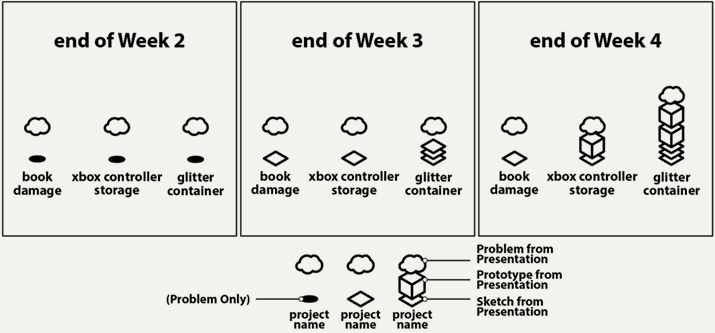
Figure 16. Typical design project artifact progression.
Figure 17 depicts how design-based making, while still involving sketches and prototypes, followed an atypical progression through the same three weeks shown in Figure 18.
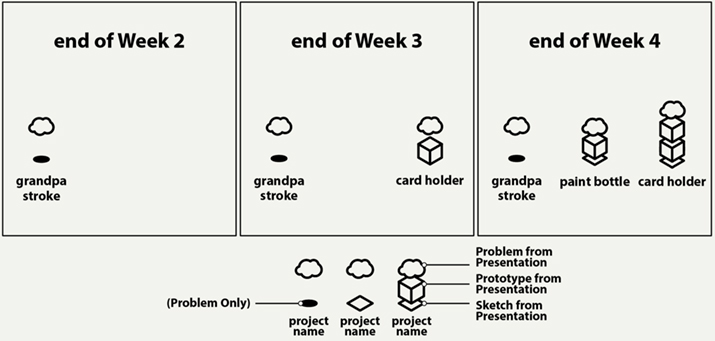
Figure 17. Atypical design project artifact progression.
Figure 18. Snapshots show the egocentric network emergence diagram of the glitter container design project.
(Click to see the larger image.)
In Figure 17, grandpa stroke starts with a problem presentation in Week 2, and then no one makes any artifacts to contribute to the project in Weeks 3 or 4. Paint bottle debuts in Week 4 with a problem, sketch, and prototype simultaneously. Card holder starts with a problem and a prototype, but no sketch, then adds both a sketch and a prototype in Week 4.
Design-based Making Facilitates Asynchronous Collaboration
In Figure 18, we can see that the youth who worked on the glitter container project did not always attend the same sessions. Nevertheless, they were able to use design-based making to add sketches and prototypes to the design project, addressing P109’s needs. Youths’ presentations of their design-based artifacts, as well as the artifacts themselves, remained in the Improve Our Club! room from session to session, where they were accessible to all youth working on the same design project. In this way, Figure 14 and Figure 18 provide an answer to how design-based making promotes engagement in PYD goals by visualizing how video-recorded presentations and design-based artifacts facilitated collaboration between youth over time in an asynchronous fashion. By the end of Improve Our Club! program, three youths—P106, P111, and P129—had made four sketches and five physical prototypes to address P109’s problem, thereby connecting with one another via their design-based making despite doing so in an asynchronous manner.

